

In order to make your MicroSquirt® controller work on a vehicle, you will need the following additional fuel system items to suit your installation:
If your vehicle is already fuel injected, it will most likely have all these components in place. Some later vehicles use PWM on the fuel pump electrical supply to set the fuel pressure, rather than use a regulator, these should be retrofitted with a vacuum referenced fuel pressure regulator for best operation with your MicroSquirt® controller.
Note that if you start by installing your MicroSquirt® controller with a throttle body injection unit from a late model vehicle, it will likely come with the injectors, pressure regulator, and throttle position sensor; this will greatly simplify the installation of your MicroSquirt® controller on a vehicle that was previously carbureted. If you choose a TBI unit, you will not need as much wiring, fuel rails, manifold modifications for injector bungs, etc. Once you get the TBI set-up working, you can later switch to port injection and use the TBI as an air door only.
Information on selecting injectors for your MicroSquirt® controller is here: Injector Selection for Your MicroSquirt® Controller
You can get information on injector bungs for port injectors by checking out www.sdsefi.com for injector/manifold installation information, along with lots of other great information. The bungs are 0.530"-0.535" inside diameter [about 17/32" or 13.5 mm]. The fuel supply lines for the top of the injectors are the same size.
VERY IMPORTANT! If you do not own at least two fire extinguishers, go buy some right now! Experimentation with EFI can be very dangerous because you are playing with high pressure gasoline. Install at least one fire extinguisher in your work area (away from where the fire is mostly likely to occur) and carry another one in your car. Do not ignore this advice. We do not want to be visiting you in the hospital or worse!
MSD and others have an “Epoxy-In Pocket” fuel injector bung as PN 2120 (set of 8). Holley also offers them as PN 534-83 for a four pack (~$50), 534-84 for a pack of six (~$72), or 534-85 for a pack of eight (~$94).
These bungs can be held in place with epoxy or welded and is used for fixed fuel rail systems only. These bungs are CNC-machined from aluminum for precise dimensions and have a ¾” OD. Internally, the pockets are contoured to accept the bottom sealing O-ring of a standard injector. MSD also has “Thread-In Pockets”. The aluminum pockets will screw into a ¾”–16 hole and are supplied with a #8 O-ring to seal the pocket to the manifold. PN 2125 gets a set of 8.
Fuel Rails
Most injector systems will use one or more fuel rails. These serve two functions: they supply fuel to a multiple number of injectors (4 on a 4 cylinder, for example), and they physically locate the tops of the injectors. Most OEM rails can be made to work with standard engine configurations, but if you are doing a custom conversion you may have to fabricate fuel rails. Many place supply blank aluminum fuel rail extrusions in whatever length you need. One example is Ross Machine. They have two styles of fuel rail extrusion. They can also create custom fuel rails for you, with the injector holes placed to suit you.
The aluminum extrusion comes in two sizes:

For fabricating fuel rails, MSD has “Fuel Delivery Top Mounts”, PN 2115, set of 8. These fuel delivery mounts are CNC machined from #304 stainless steel for great durability and precise dimensions. They slide over ½” steel tubing (MSD PN 2205) then are brazed or TIG welded in place to form a fuel rail. Fuel is routed through a 5/16” hole aligned to the mount and the injector. The PN 2105 Fuel Rail Clip is required for assembly. Their “Stainless Steel Fuel Tubing”, PN 2205, comes in 2 four feet lengths of 304 stainless steel tubing, and is perfect for making custom fixed rails. The seamless tubing has a ½” OD and .035” wall.
Your throttle body choice depends on whether you are going to use throttle body injection or port injection.
Your throttle body needs to do 2 things:
Some people use the complete individual runner (IR) throttle body and injector set-ups off late model motorcycles - they often have enough flow for automotive engines, and are frequently available cheaply on eBay.
However, if you are planning on a throttle body injection set-up, you need a dedicated TBI unit (in order to supply the fuel to the injectors, etc.), which can be hard to find for larger engines - Holley has made a 4bbl TBI for years (in 650, 700 and 900 cfm sizes), and as the computer fails regularly on these, they are sometimes available separately on eBay. TBIs have the advantage of having the fuel pressure regulator built in.
Note that for either port or throttle body injection you can use multiple throttle bodies to support your power levels, if your manifold configuration can be adapted for them.
When selecting a throttle body, there are a number of considerations. You need it to flow enough to support your engine's horsepower (or more correctly, to not restrict your engines power). Generally, you want to take the throttle body from an engine that made similar horsepower to your engine.
However, if you are uncertain of your throttle body's application, you can measure the throttle bore size. However, you can't really compare the throttle of an EFI throttle body to the throttles of a carb. This is because the throttle(s) of a EFI TB is the main restriction, but on a carb, it is the venturis that are the main restriction. So you really have to compare the EFI throttle size to the carb's venturi size. However there are also a number of other considerations, such as that you can go larger with a EFI TB than a carb without suffering so many adverse effects because a vacuum signal isn't needed for the EFI to operate. Fuel delivery is always good with EFI (well, mostly).
However, there are some drawbacks to a too large throttle body:
For reference, the GM tuned Port Injection engines used throttle bodies with two 48mm throttles. These support about 230 horsepower, however these throttles were not the limiting factor in the power produced by these engines.
To calculate how much horsepower you can make from a given throttle body size, you can use the estimator below:
Fuel Supply System
In order to use your MicroSquirt® controller, you will have to implement a high-pressure fuel supply system. You MUST understand how to do this properly, and this manual DOES NOT include everything you need to know. If you are unsure about your installation, have a qualified mechanic look it over before attempting to start your vehicle.
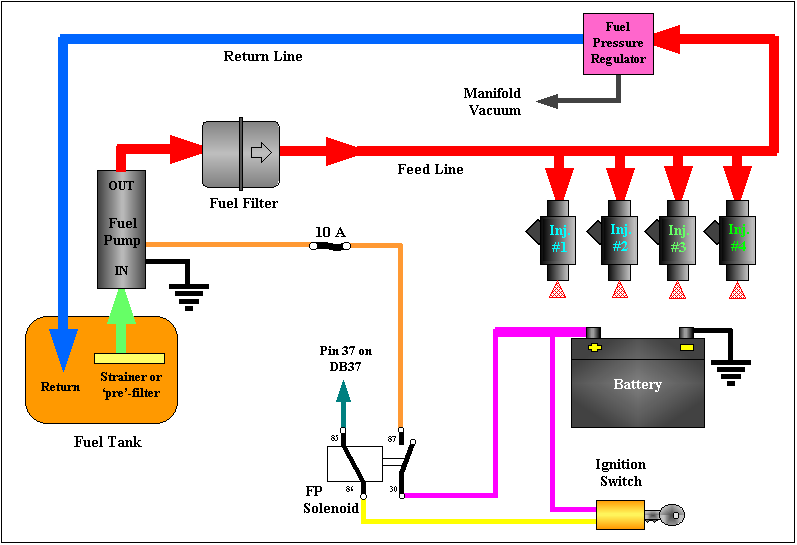
You will need a high pressure pump with enough volume at your operating pressure to feed you engine under maximum load. Typical pressures needed in the neighborhood of ~45 psi for port fuel injection, ~10-20 psi for TBI injection. A port injection pump will work with TBI, but not vice-versa.
OEMs usually place pump inside the fuel tank. In an EFI retrofit it is generally easier to use an external fuel pump. Ford used external fuel pumps on 1989 era 150 trucks which may be a candidate for use. These are high pressure [port EFI] pumps that will work in most applications. Econoline vans have these as well.
The external pumps used in Ford F150 fuel injected trucks from the 89-93 model years are Delco EP286. At 12 volts, the operating pressure is 70-95 PSI with 36-40 gals per hour. The biggest Delco pump is the EP424, which is 75-90 PSI at 40 gals per hour. EP 268 is a GM# 25117086, EP 424 is a GM# 25176156."
Here is a picture of the Econoline pump:
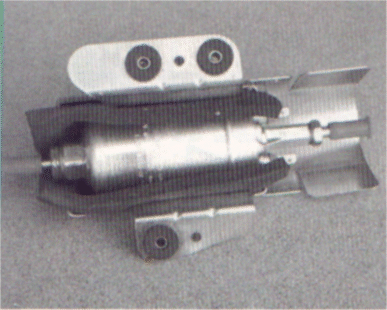
The Carter pump #P70199 (the outlet is 7/16 standard pipe thread and the inlet is 15/32 clamped hose type fitting or 3/4 standard thread. The specs are 95-PSI max, 68-93 G/Hr wide open). This is the highest flowing Carter external fuel pump in the book. It will produce up to 95 psi, and crosses over to EP7107 at Kragen for about $80 (unfortunately one end does not come off like the Carter). You might want the Ford style pump EP7109($80). You will need this if you want to be able to modify ends to be 3/8".
Others have had luck using the external pump from various fuel injected VolksWagen models (87 VW Fox, for example). Part number is: Bosch 0 580 254 957 reportedly rated at 90 GPH@ 70PSI, you might find them for about $130 new from www.germanautoparts.com. This pump consists of a fuel pump, filter, and an "accumulator". You can leave the accumulator in place since it does not affect the running volume or pressure, and on used pumps they are often rusted so you might not want to mess with it.
Auto Performance Engineering has many high volume Walbro pumps (and their specifications) on their site.
Steel tubing is recommended for most locations, but you MUST have short sections of rubber line in the feed and return lines between the engine and frame to allow for engine movement. The return line should have minimal restriction. For reference, GM systems typically have 3/8" feed lines and 5/16" return lines.
You may be able to use your original fuel line as a return line, plumbing a new 3/8" (10mm) line for fuel supply. You can run the return line into the tank, or reroute it to a fitting or nipple you install in the fuel tank filler neck/tube assembly (in which case you may be able to use the original pick-up for your supply line). If you run a new pick-up into the tank, it will need a filter. GM sells a sock-type filter that is a good fit for 3/8" lines. It is part number 5651702 and costs about $15.
You may have to fabricate fuel lines for your system. Tubing is available in steel, stainless steel, and aluminum for this purpose. The size is generally given as the outside diameter of the tubing. Unless you have a very unusual combination (or very high horsepower, well over 500+), you should be able to use 3/8" tubing for both the supply and return lines.
Buy a good tubing bender (there are numerous styles in various price ranges) so that you don't kink or collapse the tubing while bending it. (You can also bend it over a V-belt pulley, in some cases.)
The AN (Army-Navy) 'dash' system of hose and fitting sizing was established many years ago by the American military as a common measurement for hoses and fittings. It designates the outside diameter of the metal tube that is compatible with each size of fitting. The AN dash measure is the standard for performance hose applications. These dash sizes are expressed in 16th of an inch. For example, an -06 fitting is 6/16 of an inch or 3/8", just right for our fuel lines!
Most fittings and adapters in the automotive aftermarket are based on a 37° sealing angle (SAE J514 37° - formerly known as JIC). These are also often referred to simply as AN fittings. Male and female 37° fittings will mate together for a leak-proof connection.
| Dash Size | Inch Size | Nominal Thread Size |
| 04 | 1/4 | 7/16-20 |
| 05 | 5/16 | 1/2-20 |
| 06 | 3/8 | 9/16-18 |
| 08 | 1/2 | 3/4-16 |
| 10 | 5/8 | 7/8-14 |
Be aware that there are other similar fittings and adapters that use a 45° sealing surface (SAE J512), such as those commonly available at your local hardware store for flared copper pipe. These 45° fittings and adapters can also be found in some OEM automotive applications. However, although they may look very similar to a 37° fitting, they are not interchangeable. In some sizes, they may thread together (-02, -03, -04, -05, -08, -10), but will not seal properly, due to the difference in sealing surface angles. Be sure you know the sealing angle of the fittings you are connecting!
| Dash Size | Inch Size | Nominal Thread Size |
| 04 | 1/4 | 7/16-20 |
| 05 | 5/16 | 1/2-20 |
| 06 | 3/8 | 5/8-18 |
| 08 | 1/2 | 3/4-16 |
| 10 | 5/8 | 7/8-14 |
Abrasion (the rubbing of the hose against some other component) is the number one cause of hose failure. A leaking fuel hose can start a very dangerous fire in your car, so make sure hose assemblies are routed properly to reduce the chance of any abrasion damage. Use a support every 12 to 18 inches (30 to 45 cm) to secure the hose. For chafe protection, be sure to install a grommet at any point a hose passes through a panel or bulkhead.
Besides steel or aluminum tubing fuel line, you can also use one of the steel or nylon braided hoses from various suppliers. Generally these use the same AN 'dash' sizing system, and can use appropriate fittings to connect to 37° flare, NPT thread, or other systems.
Note that if you are using a factory fuel rail, you may be able to find an aftermarket adapter to mate your OEM fuel fitting to an AN hose. For example, Accel offers TPI fuel rail fittings (pn 74730, ~$32) for -06 hose that will fit most General Motors TPI fuel injections systems.
If you need a simple way to get to a barbed fitting to connect up rubber EFI hose to the General Motors 2 bbl TBI, your local auto parts house probably stocks GM fuel line repair kits in the HELP section. These consist of 9" of steel fuel line in 3/8" and 5/16" outside diameter with an O-ring and Saginaw fittings 14/16 mm, respectively, on one end and a barbed end crimped on the other. The steel lines are about $4.00 each. These pieces thread into the steel adapters on the GM Rochester TBIs. For a complete listing of various fittings with part numbers, etc. try:
IMPORTANT: Keep the fuel lines out of passenger compartment and routed safely away from moving or hot parts to avoid damage/excessive heat. For flexible rubber hose use the SAE 30R9 EFI hose which is rated at 250 psi. EFI hose clamps are also recommended rather than gear clamps. Check with someone who knows if you are not sure about your installation. Nobody needs a 50 psi gasoline fed fire to ruin their day!
Note that if you feel your fuel supply is not smooth enough, you can add an accumulator. OEMs often have nice small diaphragm types, or you can plumb in a vertical section of rubber hose tee'd off the supply line (and plugged at the top end). This traps air and uses it to cushion the fuel pressure.
Here is a GM style accumulator (it is about 2" (50mm) long and uses 3/8" tubing):
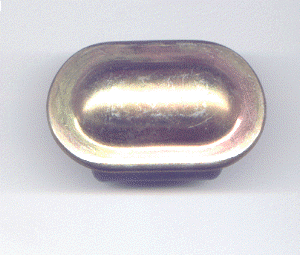
Or you can make your own:

Fuel filter
Use a fuel injection fuel filter rated for the pressure at which your system operates. DO NOT use a universal carburetor filter - the higher pressure of fuel injection systems may cause it to burst! Position the filter downstream of the pump so that a clogged fuel filter will not over heat the fuel-cooled pump.
The vacuum referenced fuel pressure regulator is essential. It provides constant pressure differential between fuel at injector nozzle and manifold air pressure [port EFI] or atmospheric pressure [TBI]. This makes the injected fuel quantity solely a function of the injector open time.
If you were to 'cap off' the manifold vacuum port on the fuel pressure regulator, you are reducing the dynamic range of the injectors. This means you will need lower pulse widths at at (giving less control over idle mixtures) and lower flow under boost (restricting the maximum horsepower).
So, in general, for port injectors, have the fuel pressure regulator connected to the manifold vacuum is a good thing. There is very little reason not to do it (though some have argued against it for individual runner port EFI set-ups).
If you have an adjustable fuel pressure regulator (FPR), set the pressure with the fuel pump running, but the engine not running - that's your base fuel pressure (it is referenced to atmospheric pressure).
The regulator is typically at the far end of the fuel rail (after the injectors), but performs its job anywhere, so long as it is after the fuel pump. However, if you have the regulator before the rails, then the full volume of fuel isn't circulating through the rails. Only the amount of fuel actually injected moves, and the fuel can get quite hot, which may require special injectors, etc. Apparently OEM use special injectors, etc., with returnless systems, which is essentially what one has if they put the regulator before the injectors. This can also create problems trapping air on assembly that can cause issues at first start-up.
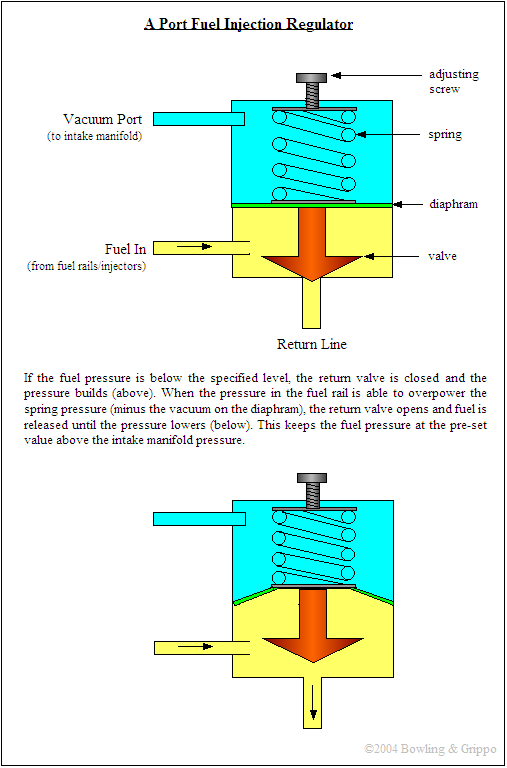
If you are using an aftermarket fuel pressure regulator, it is a good idea to also install a pressure gauge, since most of these are adjustable. For TBI, use a 0-30 psi gauge. For port injection use a 0-60 psi or 0-100 psi gauge. Most of these gauges will mount directly on a fuel fitting using a 1/8" NPT thread. These are available from most aftermarket speed parts suppliers, such as Summit Racing or Jegs.
Surge Tank
You only need a surge tank if you are using a low pressure pump to supply an external high-pressure pump. Some pumps come with an accumulator after the pump, and these can be left in place.
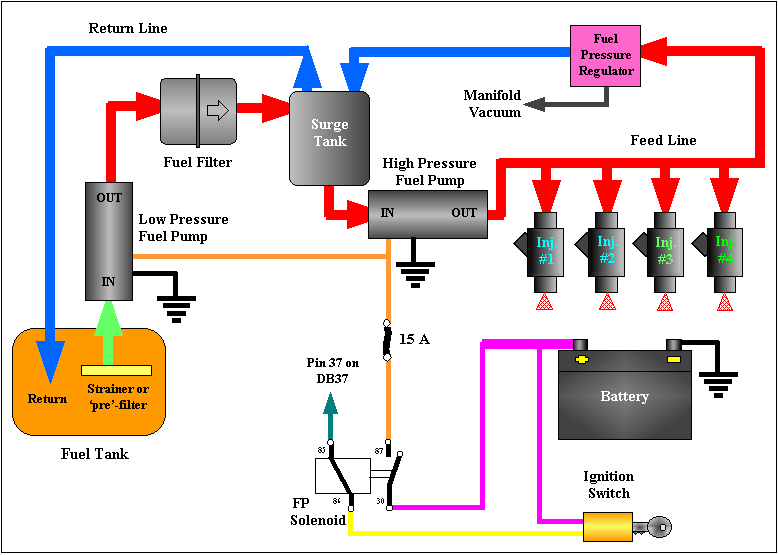
Wiring the Fuel Pump
To activate the fuel pump, your MicroSquirt® controller provides a ground for the fuel pump relay circuit on pin 37. The relay is wired for 12 volts switched from the ignition switch, and the relay is grounded through your MicroSquirt® controller [pin 37 on the DB-37 connector].
MegaSquirt will disable the fuel pump when RPM = 0 and enable while non-zero (cranking/running), except for Version 2.00 (and up) embedded software which will perform a short priming pulse, then shut down the pump if the engine is not running after 2 seconds.
You might want to consider a safety switch in the fuel pump circuit when installing an electric fuel pump. Holley has one (12-810, ~$20) that will ensure the fuel pump will not run unless the engine has oil pressure. It stops the pump from running if the motor stalls with the ignition on. Wiring the switch through the starter solenoid circuit energizes the pump on engine start-up. Once the engine has started, the switch continues to provide power to the pump as long as there is oil pressure to keep the switch turned on.
Note: An inertial safety shut off switch should be installed and used to kill power to the pump upon significant impact to vehicle.
These switches are available in junk yards from EFI Fords. The switch is on the drivers side in the trunk, near the trunk hinge, mounted so that it is between the interior bracing and the rear quarter panel (protected from being knocked around if you stuff your trunk full of stuff). It is mounted with the reset switch straight up. Note switch mounting orientation probably matters.
It is Ford Part # F2AB-9341-AA. The wire going into it is about 14 gauge, so it should be capable of handling the full current of the fuel pump.
The markings on the switch show that it has NO/NC (normally open/normally closed) positions so that it should be able to accommodate any possible fuel pump configuration.